p.73
p.81
p.89
p.97
p.105
p.111
p.119
p.127
p.135
Approach for the Automated Analysis of Geometrical Clinch Joint Characteristics
Abstract:
Due to their cost-efficiency and environmental friendliness, the demand of mechanical joining processes is constantly rising. However, the dimensioning and design of joints and suitable processes are mainly based on expert knowledge and few experimental data. Therefore, the performance of numerical and experimental studies enables the generation of optimized joining geometries. However, the manual evaluation of the results of such studies is often highly time-consuming. As a novel solution, image segmentation and machine learning algorithm provide methods to automate the analysis process. Motivated by this, the paper presents an approach for the automated analysis of geometrical characteristics using clinching as an example.
Info:
Periodical:
Pages:
105-110
Citation:
Online since:
April 2021
Authors:
Keywords:
Price:
Сopyright:
© 2021 Trans Tech Publications Ltd. All Rights Reserved
Share:
Citation:


